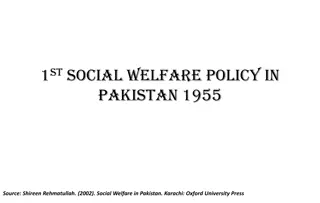
Social Welfare Systems in Europe: Evolution and Challenges
Explore the evolution of social welfare systems in Europe, examining how capitalism influenced the distribution of resources and the responsibility for addressing social problems. Discover the historical developments in European countries like Poland and Czechoslovakia before World War II, reflecting responses to crises and the establishment of social assistance programs.
Download Presentation

Please find below an Image/Link to download the presentation.
The content on the website is provided AS IS for your information and personal use only. It may not be sold, licensed, or shared on other websites without obtaining consent from the author. If you encounter any issues during the download, it is possible that the publisher has removed the file from their server.
You are allowed to download the files provided on this website for personal or commercial use, subject to the condition that they are used lawfully. All files are the property of their respective owners.
The content on the website is provided AS IS for your information and personal use only. It may not be sold, licensed, or shared on other websites without obtaining consent from the author.
E N D
Presentation Transcript
Social welfare systems in Europe Walter Lorenz
The political challenge of modernity: capitalism capitalism creates the unequal distribution forms of capital unequal distribution of all For the middle classes financial capital (property, ownership of the means of production) ensured also the acquisition of human capital (servants, labourers) so that they were free to accumulate social capital: leisure time in clubs, hobbies, trade fairs, commercial partners political parties. For the working classes this means not only less financial capital but also restrictions on social capital
central question: who is now responsible for solving social problems? individuals in which case they need to be made aware of their responsibility, probably through deterrents (threat of the workhouse) volunteers (the churches, humanitarian projects, philanthropy) by helping informally public organisations police, institutions (schools, hospitals, asylums), social workers.
State Civil society (community) Private sphere (individuals, market)
European welfare developments before before World War II Largely responses to crises (war-effects, pandemic!, unemployment, poverty, class division): uneven development, political compromises. In post-Habsburg countries, the social institutions created were directed at mitigating needs of people who were in particularly difficult situations. Law on social care passed in Poland in 1923 endured until 1990, typical for Central and Eastern European countries (Zalewski 2005). Social assistance was based on the local authorities' cooperation with local civic organisations responsible for the fate of the poorest people. In Poland mainly religious organisations (Caritas), benefits predominantly in kind: food, accommodation, fuel in winter Reliance on container institutions (asylums for poor, disabled, mentally ill, orphaned people)
Czechoslovakia - Social policy during the first republic After the end of World War I, laws on unemployment benefits,eight- hour working hours and the disbursement of pensions to disabled veterans and the bereaved of the fallen. In 1924, sickness insurance was reformed, and disability and old-age insurance of the workers employed in the private sector was codified. The economic crisis of the 1930s decreased social activities: e.g. the state aid scheme for the unemployed was modified so that only union members were entitled to the benefits; the housing protection programme was gradually reduced until 1937 when it was completely abolished.
Czechoslovakia after 1945 In 1947,a comprehensive social insurance scheme was adopted for all employed persons and the National Insurance Company was founded. 4 types of insurance: accident, old-age, sickness and unemployment insurance. old-age pensions, 3 categories according to the sector in which they worked (the retirement age differed). Since poverty was abolished , benefits for the poor did not exist; although, they were later reintroduced but without legal support, which means that they did not officially exist until 1991 (Kvapilov , 2010). From the 1950s to the 1980s, the state-funded social services were distributed through employers. In 1974, the family policy was reformed to promote a higher natality rate (the so-called Hus k s children). Leninist model of the welfare state
History of Soviet welfare measures 1917-1992 Utopian era (post 1017 revolution): Lenin promises comprehensive social security measures (income maintenance) cannot be kept because of economic difficulties Realism: 1920s limited protection for skilled workers, investment in health and education, concentrated on urban areas (solidarity of workers) Industrial emphasis (1928): unemployment benefits abolished by Stalin, work a civil duty, doctors mainly attached to hospitals (control of real illness ); investment in education (future labour force) housing, disability, pensions neglected. 1950s Khrushchev reaffirms original social policy commitments: equality, public housing, workers access to higher education, old-age pensions doubled. Constant threat: only economic growth can guarantee the realisation of the plans state is forced to become practically a capitalist entrepreneur (workers do not receive the full benefit of the surplus they produce). Social policy is used to support the economy primarily, not the needs of the population.
Fundamental, contrasting notions of welfare Socialist welfare Marketised welfare Core principles Equality: to each according to their needs Liberty: to each according to their abilities / efforts Anthropology Humans are inseparable of community (the collective creates individuals) Humans are free agents making rational choices in their own interest, individuals choose groups Provider of main support the collective (the state) The individual (as entrepreneur) Process Social planning (collective targets) Loss of freedom, state control Market as efficient distributor of goods according to demand Deep social divisions Dangers
Renewed support for public welfare after World War II in Western Europe motives: Reward for returning soldiers ( a country fit for heroes , Britain) war bonus Anti-fascism, anti-Nazism bonus: promoting a voluntary commitment to the nation, de-centralised organisation Anti-communism (Cold War bonus): The West has to look after citizens better than the East; German model: Social Market Economy Trend towards de-commodification : everybody should be able to benefit from support irrespective of personal financial resources social class equality bonus
Principle of De-commodification (Esping-Andersen) De-commodification occurs when a service is rendered as a matter of right, and when a person can maintain a livelihood without reliance on the market. De-commodification strengthens the worker and weakens the absolute authority of the employer. - Which social services today are de-commodified and to what extent?
Main welfare concerns in the first decades after World War II secure growth, full (male) employment, predictable welfare needs (education, health, pensions, housing) homogenous societies, dominance of class over identity-politics ad national political-economic independence
How many of those bonuses are still valid today after 1989? War a long time past Fascism and Nazism not seen as an issue of social policy Cold War resolved after 1989 Class differences stimulus for individual effort (activation)






















